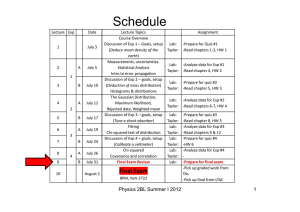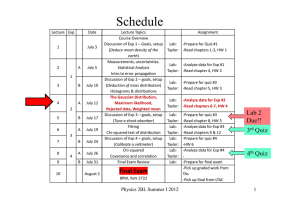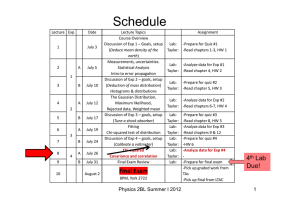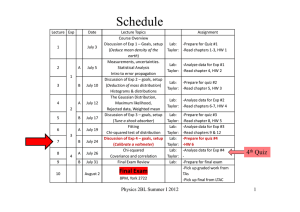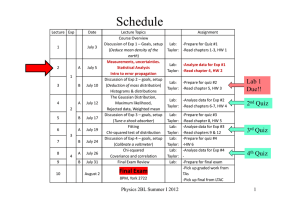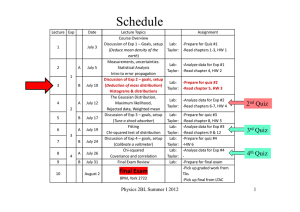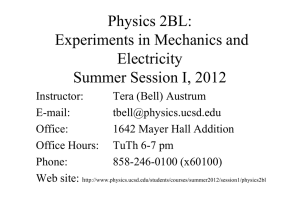Schedule
advertisement
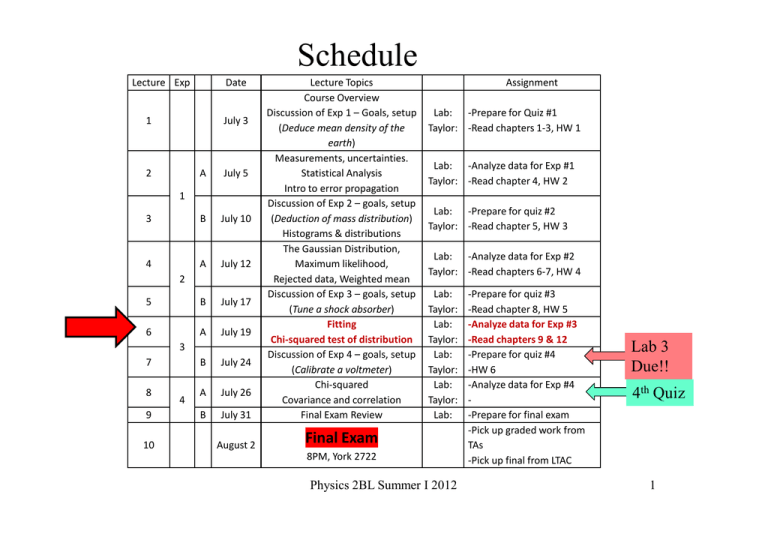
Schedule Lecture Exp Date B July 24 A July 26 B July 31 Lecture Topics Course Overview Discussion of Exp 1 – Goals, setup (Deduce mean density of the earth) Measurements, uncertainties. Statistical Analysis Intro to error propagation Discussion of Exp 2 – goals, setup (Deduction of mass distribution) Histograms & distributions The Gaussian Distribution, Maximum likelihood, Rejected data, Weighted mean Discussion of Exp 3 – goals, setup (Tune a shock absorber) Fitting Chi-squared test of distribution Discussion of Exp 4 – goals, setup (Calibrate a voltmeter) Chi-squared Covariance and correlation Final Exam Review August 2 Final Exam 1 July 3 2 A July 5 3 B July 10 4 A July 12 5 B July 17 6 A July 19 1 2 3 7 8 9 10 4 Assignment Lab: -Prepare for Quiz #1 Taylor: -Read chapters 1-3, HW 1 Lab: -Analyze data for Exp #1 Taylor: -Read chapter 4, HW 2 Lab: -Prepare for quiz #2 Taylor: -Read chapter 5, HW 3 Lab: -Analyze data for Exp #2 Taylor: -Read chapters 6-7, HW 4 Lab: Taylor: Lab: Taylor: Lab: Taylor: Lab: Taylor: Lab: 8PM, York 2722 Physics 2BL Summer I 2012 -Prepare for quiz #3 -Read chapter 8, HW 5 -Analyze data for Exp #3 -Read chapters 9 & 12 -Prepare for quiz #4 -HW 6 -Analyze data for Exp #4 -Prepare for final exam -Pick up graded work from TAs -Pick up final from LTAC Lab 3 Due!! 4th Quiz 1 Introduction to Linear Least Squares Fitting χ2 analysis Lecture # 6 Physics 2BL Summer Session I 2012 Physics 2BL Summer I 2012 2 Lecture #6: • Issues from experiment 3? – Tuesday you will need to turn in your lab notebook/report before the end of lab – Start it at home! (may need to retake data) • Experiment 3 writeup • Recap: – Principle of Maximum Likelihood • Linear Least Squares fitting • Chi-Squared • Homework Physics 2BL Summer I 2012 3 Exp 3 - Measurements • Make sure to include ALL measurements (with uncertainties) in the same section ∆x • Thickness of the mass ? – Did you measure the correct thickness? – If not, how does this affect your lab results? Physics 2BL Summer I 2012 4 Exp 3 - Graphs • Graphs of velocity vs drop height – Only for 4 and 5 holes open – Discuss trends and their meaning! – Answer questions: “Will the mass reach terminal velocity for 6 or 7 holes open? Etc…” • Graph of b vs # holes open – draw smooth line thru data and plot bcrit as a horizontal line – Estimate # holes open for critical damping Physics 2BL Summer I 2012 5 Exp 3 - Calculations • Make sure to do every part of the rubric • Calculate kspring with uncertainty (using the period) • Calculate kby-eye with uncertainty (using ∆t* at critical damping) b 2 bcrit = 2 mk – According to model mg b = – Terminal velocity vt ∆x – Kinematics vt = k= k= 2 mg 2 4vt ∆t * kby −eye crit 4m g∆t * = m 2∆x 2 • How did you know you reached critical damping? • Calculate a weighted mean for k (with uncertainty, as usual) Physics 2BL Summer I 2012 6 Exp 3 - Conclusion • Comparison of kspring and kby-eye using tscore – Determine the level at which the 2 values are discrepant • Discuss error: – Specific sources of random or systematic error – How you reduced random/systematic error – How can you improve? Physics 2BL Summer I 2012 7 Recap • Principle of maximum likelihood 1 − ( x − X )2 PX ,σ ( x ) = e σ 2π 2σ 2 – L = P(x1)P(x2)…P(xN) – Prove that the mean maximizes the X = x δX = σ x likelihood when errors are equal – Prove that the weighted mean maximizes the likelihood when errors xi wi are different 1 ∑ X = xwav = δX = σ wav = ∑ wi ∑ wi • Minimize chi-squared χ 2 N = ∑ i =1 xi − X σi wi = 2 Physics 2BL Summer I 2012 1 σ i2 = 1 (δxi )2 8 Fitting Data • We often fit data using a maximum likelihood Bx + Cx + … method to determine parameters. yy == AA +cos(Bx + C) + D • For errors which are “Normal”, we can just minimize the χ2. 2 2 ∂χ =0 ∂X • We will use this method to fit straight lines to data. • More complex functions can be fit the same way. To determine a straight line we need 2 parameters. How do we get 2 equations? Physics 2BL Summer I 2012 9 LINEAR FIT: y(x) = A + Bx minimize 30 Σ [yj-(A+Bxj)] 2 True value, X(xj) 20 y((x) y4-(A+Bx4) y3-(A+Bx3) 10 Assumptions: δxj << δyj ; δxj = 0 yj – normally distributed σj: same for all yj 0 0 5 10 15 x 20 Physics 2BL Summer I 2012 25 10 Linear Fit • Determine A and B by minimizing the square of the deviations between your measurements and the “theory”. Minimize → ∑ (y i − (A + Bx i )) 2 i Measurements “Theory” Physics 2BL Summer I 2012 11 LINEAR FIT: y(x) = A + Bx 2 ( ) − y − y 1 j true Pr ob(y j )∝ exp 2 σy 2σ y 30 y(x) 20 10 0 0 5 10 15 20 25 2 − (y j − A − Bx j ) 1 = exp 2 σy 2σ y Pr ob(y1 , y 2 ,... y N ) = Pr ob(y1 )× Pr ob(y 2 )× ... × Pr ob(y N ) x 2 − (y1 − A − Bx1 )2 − (y N − A − Bx N ) = N exp + ... + 2 2 σ 2σ y 2σ y N − (y − A − B )2 1 1 1 j j = N exp ∑ = N 2 N (y − A − B )2 σ σ σ 2 j =1 y j exp ∑ j 2σ y2 j =1 2 [y -(A+Bx )] Best estimates of A&B max Prob(y1…yN) min j j 1 Physics 2BL Summer I 2012 Σ 12 LINEAR FIT: y(x) = A + Bx 30 To determine A & B need to [yj-(A+Bxj)] y(x) Σ minimize: 20 2 10 0 0 5 10 15 20 25 x ∂ ∑ (y j − A − Bx j ) 2 ∂A ∂ ∑ (y j − A − Bx j ) =0 2 ∂B =0 A= 2 x ∑ j ∑ yj − ∑ xj∑ xj yj B= N ∑ x − (∑ x j ) 2 j 2 N∑ xj y j − ∑ xj ∑ y j N ∑ x − (∑ x j ) 2 j Sometime denote: ∆ = N∑x − 2 Physics 2BL Summer I 2012 2 (∑ x) 2 13 Deducing Errors • As in the case of experiment 2, sometimes we can’t estimate the errors too well before-hand. • In such cases we compared many measurements to the mean and computed the RMS. • In this case we will compare to deviations from a line – 2 Dimension “extension”. σy 2 N 1 2 ( yi − A − Bxi ) = ∑ N − 2 i =1 Note that now we use (N - 2) because we have fit 2 parameters. Where did we use (N-1)? Physics 2BL Summer I 2012 14 Motivation for the (N-2) • Averages (1 parameter) – no deviations from one point 1 N 2 (xi − x ) σx = ∑ N − 1 i =1 – “reduced” deviations from two (or more) points • Straight lines (2 parameters) – no deviations from two points 1 N 2 ( ) σy = y − A − Bx ∑ i i N − 2 i =1 – “reduced” deviations form three (or more) points Physics 2BL Summer I 2012 15 Uncertainties in y, A, and B σy = 1 N 2 uncertainty in the measurement of y ( yi − A − Bxi ) (If we already have an independent ∑ N − 2 i =1 estimate of the uncertainty in y , …, y we 1 σA =σy σB = σ y expect this estimate to compare with σy) 2 x ∑ uncertainties in the constants A and B given by error propagation in terms of uncertainties in y1, … , yN ∆ N ∆ ∂A σ A = ∑ σ y i =1 ∂yi N Where ∆ = N∑x − 2 N (∑ x) 2 2 Physics 2BL Summer I 2012 16 How good is my fit? χ2 test for fit y j − f (x j ) χ = ∑ σy j =1 N 2 Roughly speaking: ~ N it’s a good fit >>N it’s a Bad fit 2 30 y(x)) 20 10 How good is the agreement between theory and data? 0 0 5 10 15 20 25 x Physics 2BL Summer I 2012 17 χ2 test for fit y j − f (x j ) 2 χ = ∑ σy j =1 N 30 2 Define reduced χ2 χ 2 ~ χ = d 2 20 y(x)) # of degrees of freedom d=N-c 10 # of data points 0 0 5 10 15 20 25 # of parameters calculated from data (constraints) x Physics 2BL Summer I 2012 18 The Chi-Squared Test • Minimized χ2 (maximize likelihood) to fit data • Use χ2 to determine if we used a good hypothesis • Reduced χ2 will be nearly 1 for good fit (χ2 ~ d) • Use χ2 per degree of freedom to compute a probability that the data are consistent with the hypothesis (table D) • Probability from table = confidence level y j − f (x j ) χ = ∑ σy j =1 N 2 2 d=N-c χ~ 2 = ( χ2 d 2 Pd χ~ 2 ≥ χ~0 ) Disagreement is “significant” if probability is less than 5% Disagreement is “highly significant” if probability is less than 1% Physics 2BL Summer I 2012 20 Summary - Fitting • You have a set of measurements and a hypothesis that relates them. • The hypothesis has some unknown parameters that you want to determine. • You “fit” for the parameters by maximizing the odds of all measurements being consistent with your hypothesis. • Evaluate your fit based on the goodness of fit. Physics 2BL Summer I 2012 22 The Chi-Squared Test for a distribution • You take N measurements of some parameter x which you believe should be distributed in a certain way (e.g., based on some hypothesis). • You divide them into n bins (k=1,2,...,n) and count the number of observations that fall into each bin (Ok). • You also calculate the expected number of measurements (Ek), in the same bins, based on some hypothesis. Uncertainties in Counting: 2 • Calculate: n Ok − Ek ) ( 2 q = N (integer #) δ (Ek ) = Ek χ =∑ i =1 Ek • If χ2 < n, then the agreement between the δq = N observed and expected distributions is acceptable. • If χ2 >> n, there is significant disagreement. Physics 2BL Summer I 2012 23 Degrees of Freedom for a distribution • Number of degrees of freedom, d = number of bins, n, minus the number of parameters computed from the data and used in the calculation. • d = n ‐ c, – Where c is the number of parameters that were calculated in order to compute the expected distribution, Ek. – It can be shown that the expected average value of χ2 is d. • Therefore, we define “reduced chi‐squared”: ‐ χ% 2 = χ2 nd.o.f. • If the reduced chi-squared is ~1, there is no reason to doubt the expected distribution. Physics 2BL Summer I 2012 24 Homework • Finish Experiment # 3 • If you need to retake data, visit Chris’s office hours (M 10am-12pm) • Read Taylor chapters 9 & 12 • Start analysis so you finish lab 3 on time! Physics 2BL Summer I 2012 26
